Attio vs Notion: Which Is a Better Choice in 2025?

Dealing with deadlines and completing projects on time is something that everyone working has to deal with on a daily basis. In fact, there are around 90 million professionals around the world who mainly concentrate on managing projects and deliverables.
With many people operating in this industry, trying to deliver the best value to their customers, it is crucial to have the backing of robust platforms to help you make the right decisions. Having said that, tools like Attio, Notion, and Zixflow allow you to build solid relationships with your customers and increase sales engagement.
However, choosing one software out of these three is hard. So, to help identify the perfect match for your unique business requirements, I will compare these platforms on a variety of factors. But I dive into individual features, let’s look at them at a glance to give a general idea about their offerings.
A brief comparison of Attio vs. Notion vs. Zixflow
Below is a table with a brief comparison of Attio, Notion, and Zixflow, allowing you to get insights into their features.
| Features | Attio | Notion | Zixflow |
|---|---|---|---|
| Clean User-interface | Yes | Yes | Yes |
| Multi-channel marketing | No | No | Yes, including WhatsApp, SMS, email, and RCS. |
| Unified API for all channels | No | No | Yes |
| Centralized inbox | Yes, for emails. | Yes, for internal uses | Yes, for every outreach communication & permission control. |
| API docs | Yes | Yes | In-depth |
| Contact management | Yes | Yes | Robust & flexible |
| Pay-as-you-go payment structure | No | No | Yes |
| AI-powered custom fields | No | Yes | Yes |
| Advanced segmentation and tagging | No | No | Yes, custom lists for multiple use cases. |
| Reporting dashboard | Yes | Yes, via templates | Yes |
| Table and Kanban View | Yes | Yes | Yes |
| Email sync | Yes | Yes | Yes |
| LinkedIn extension | Yes | Yes | Yes |
| Forms | No | Yes, through integration. | Yes, in-built form builder. |
| Mobile App | Yes | Yes | Yes |
| Onboarding in under 5 mins | Yes | Yes | Yes |
Attio, or Notion, or Zixflow: An in-depth comparison
Now, that you have a basic understanding of these solutions, it’s time to take a look at them comprehensively. So, let’s dive into it starting with the looks.
User interface
A platform with a good UI can greatly increase efficiency and reduce the time you have to spend on understanding how the platform works. A user-friendly interface allows users to get used to the software and make the most of it.
Attio
Attio’s UI is intuitive and flexible, making it a good choice for new users and businesses. The platform looks visually appealing and fun to use with a variety of colors, tags, fields, and symbols. This aspect alone makes it a better choice to manage your customers’ data than spreadsheets that look too plain to work with.
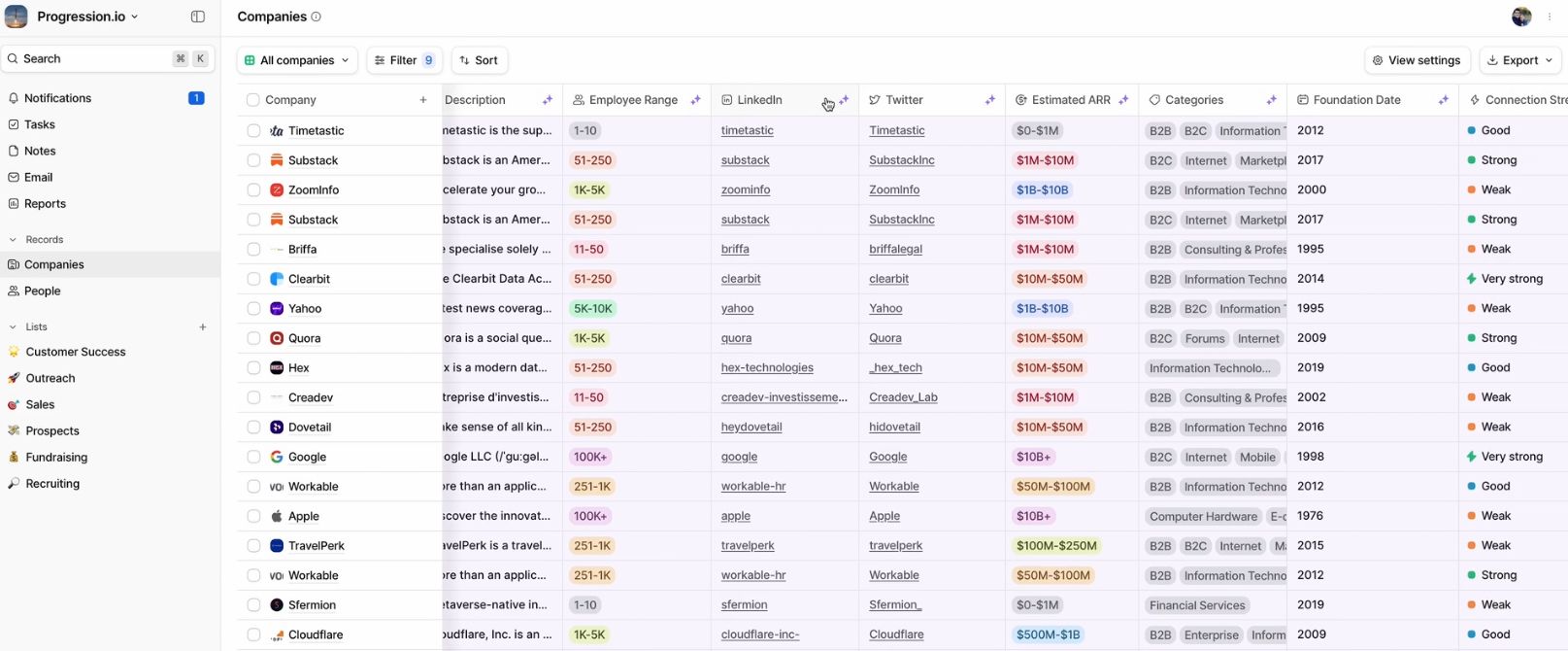
Notion
Notion is also known for its dynamic interface, where you can easily find relevant information by effectively moving around the platform. Similar to Attio, it lets you make the software your own by changing the way it looks and feels. Although having these customization options is a great addition to that platform, it might become a little complex for first-time users to get used to the interface.
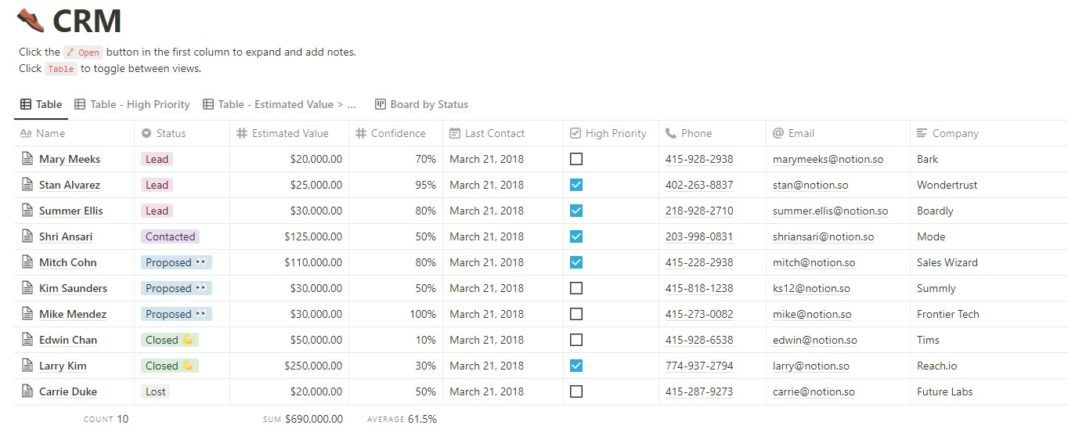
Zixflow
Zixflow has a sleek and friendly interface that doesn’t feel like a hassle to work with every day. The UI is designed in such a way that all the features or options are self-explanatory and you do not need to waste time figuring out what a particular option does.
Furthermore, like Attio and Notion, you can customize Zixflow to see customers’ details in the standard Table view or make use of the Kanban view to assess which stage of the sales pipeline the lead is in and how much time it will take to convert it into a customer.
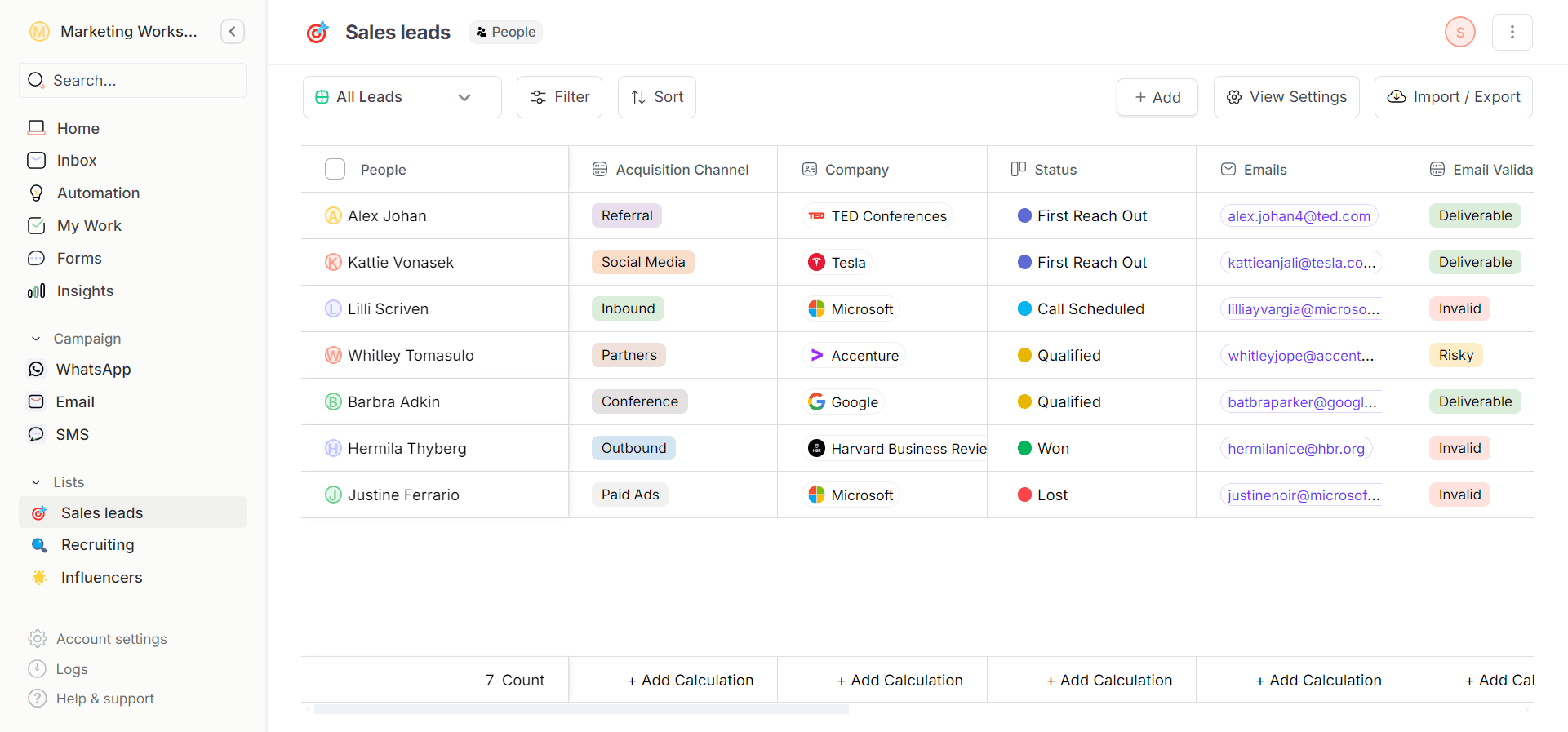
Contact management
The bread and butter of a CRM solution, powerful contact management capabilities let you effectively handle data stored within the database and find the right contact immediately whenever you need. With that said, let’s see what Attio, Notion, and Zixflow have to offer when it comes to managing customer data.
Attio
With Attio, you can correctly save your data and build in-depth customer profiles with all the relevant information such as name, company, contact information, designation, and so on in one place. This way, this information will be accessible readily the next time you open it.
In addition to that, Attio lets you optimize the data with corresponding details to ensure it is accurate. You can also give access to data to your reps for smooth sharing of information across various departments, preventing the creation of information silos within your organization.
Notion
Notion is much more of a project management tool than a full-fledged CRM platform. However, you can still use it to manage contacts using templates where you can create your own CRM to accommodate various kinds of details.
Not just that. Since Notion is a project management platform at heart, you can create custom fields in your CRM to manage notes, documents, and databases. Plus, by giving access to your teams, you can ensure this information is easily available when needed, thereby delivering quality customer engagement and using it to close more sales.
Zixflow
Zixflow, unlike Notion, comes with a native XCRM that can be molded for every situation and manage data for not just sales but for other departments, like marketing, HR, investors, and more.
With Zixflow, you can craft tailored marketing lists for segmenting contacts into the correct bucket and execute list-wide actions like reaching out to an entire list with a click. Also, you can make it so that you can see the contacts in either the Table or Kanban view, enabling you to make the most of the information.
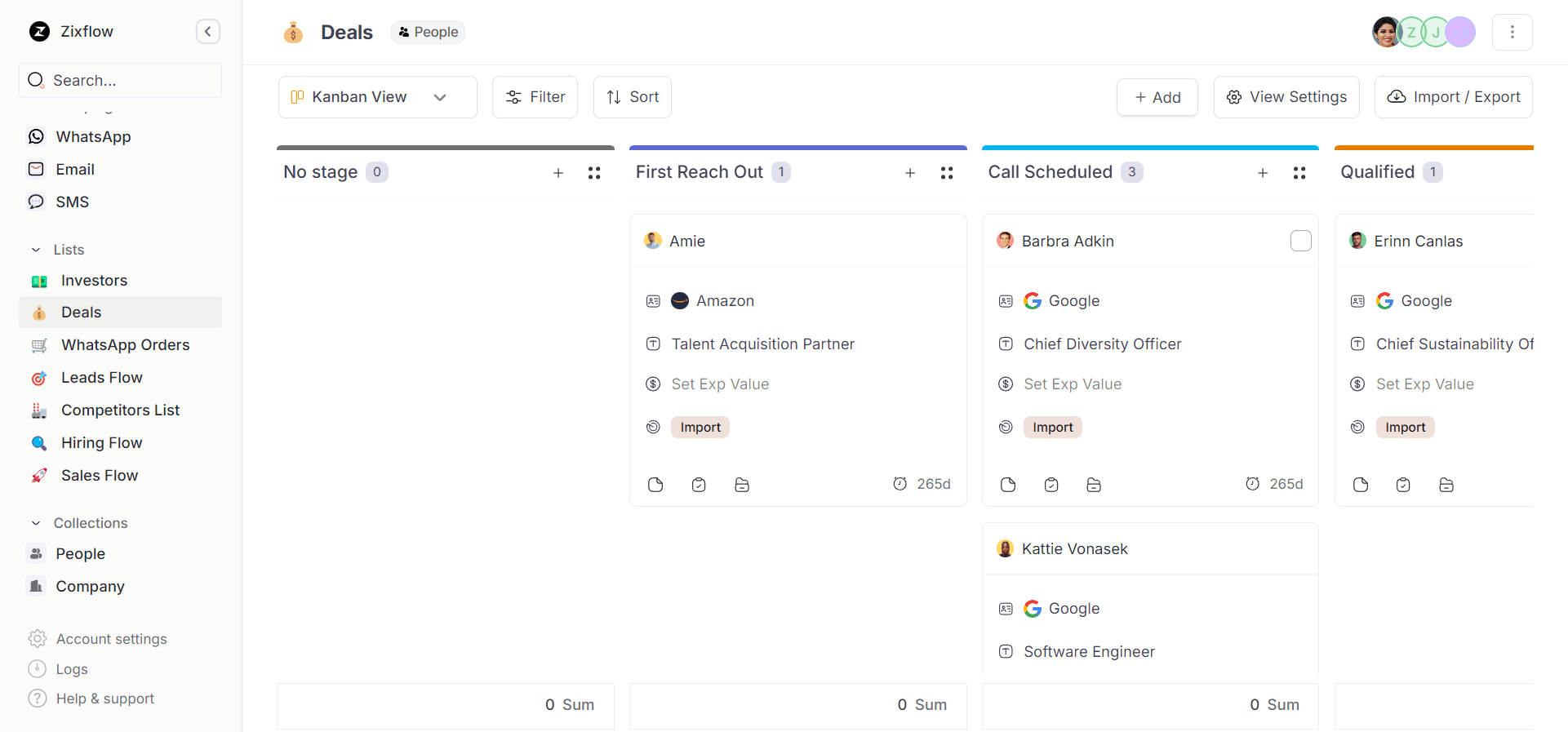
Moreover, by integrating Zixflow with external data sources, you are able to import data from third-party applications into the CRM automatically, eliminating the need to manually manage this task. Plus, this imported data can be sent to specific lists for automated lead segmentation.
Still confused between Attio and Notion?
Get started with Zixflow, a superior CRM and engagement platform.
Book a DemoOutreach capabilities
Businesses these days expect their CRMs to do more than simply manage custom data. Running outreach campaigns from the CRM has become a norm and, for this reason, when choosing a CRM, you have to consider its marketing capabilities and the channels it supports.
Attio
Attio allows you to send tailored emails to your audience directly from the CRM once you have added an address to the solution. Furthermore, by designing your own templates, you can send emails that include multiple variables to fit multiple different scenarios.
However, there is a limit to how many emails you send each month. If you are sending emails to numerous contacts at once, each batch can only include up to 50 emails simultaneously. So plan your outreach accordingly.
Notion
Notion doesn't offer an in-built marketing or outreach system like Zixflow or Attio. You can monitor your marketing efforts by building reporting dashboards using prebuilt templates or by connecting it with external platforms.
Notion is much more suitable for managing your internal projects or customer data instead of providing you with the channels to engage your customers directly.
Zixflow
When it comes to engagement, Zixflow is leagues above both Attio and Notion. On top of being a full-fledged XCRM, it is also a complete outreach solution that lets you reach out to your audience across various different channels like WhatsApp, email, SMS, and RCS.
Using Zixflow’s marketing capabilities, you can start running outreach campaigns with no-code campaign builders. Plus, if you want to engage your customers with various kinds of content, you can build personalized templates for every channel and streamline your conversations.
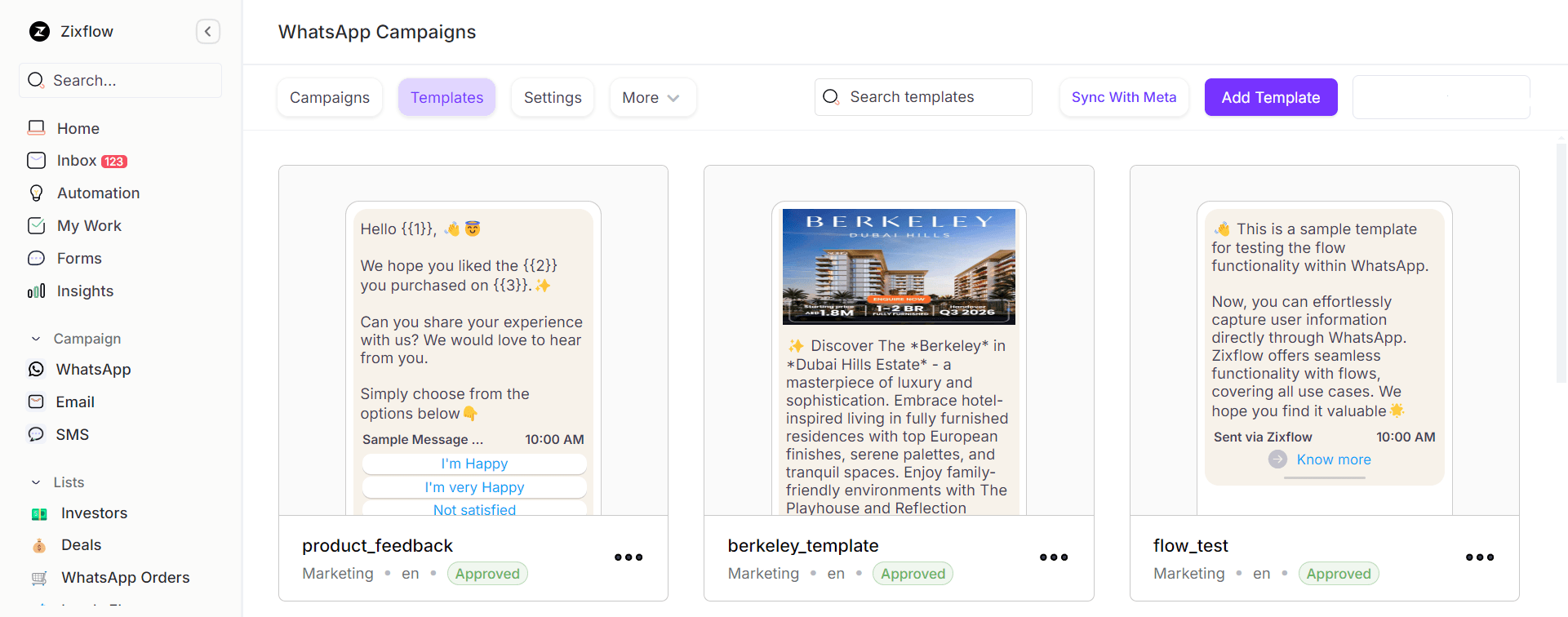
That is not all. Unlike Attio which restricts you on the number of messages you can send, Zixflow lets you forward thousands, even millions of messages to scale your brand image and tap into previously unexplored markets.
Plus, with the pay-as-you-use wallet, you will be billed just for the messages that are successfully delivered to your customers’ inbox. So, you don’t have to worry about any wasted cost on undelivered messages.
Centralized inbox
When you are running outreach campaigns to interact with your customers, it is common for them to revert back to you with any questions or queries. So, it is important to compile all these replies into a single location for you to resolve them promptly. And this is where a centralized inbox comes into play.
Attio
Attio does offer an inbox to manage your conversations but it is limited to only emails. If you interact with customers over other channels, those messages will not appear in this inbox, unless you integrate the platform with Attio.
Although it is limited in its functionality, it is still viable as you can promptly access and respond to your emails. This way, you can be on top of things and not miss out on any potential deal.
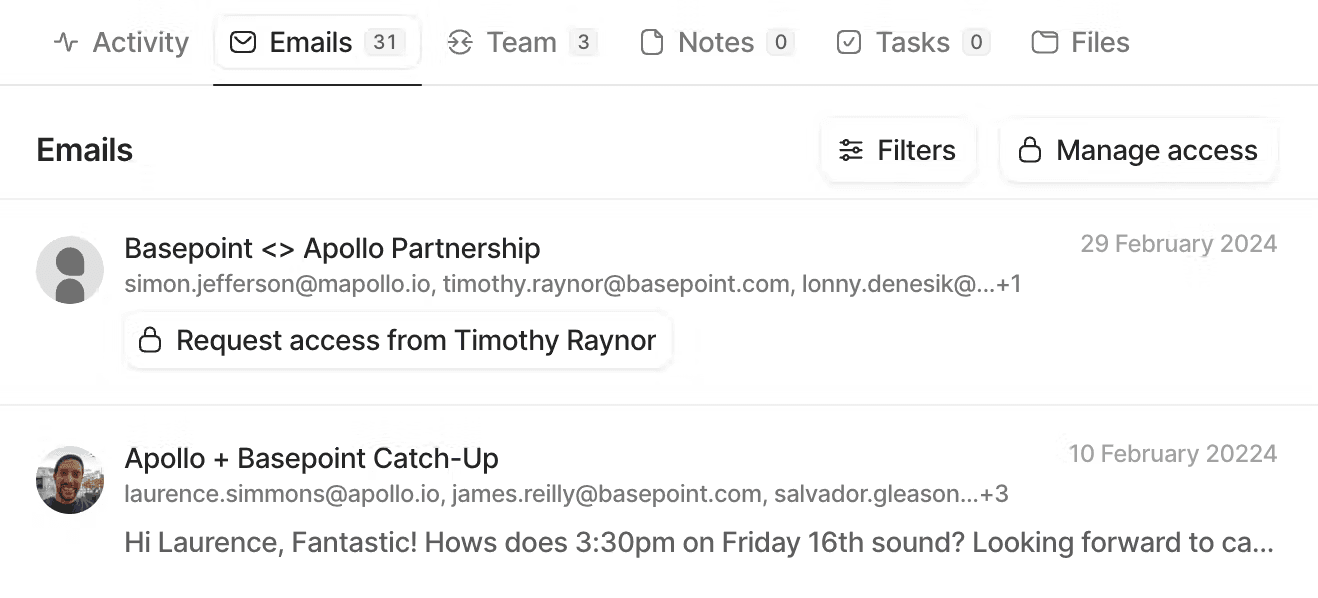
Notion
Notion’s inbox is designed to stay updated with internal collaboration and notifications. Since Notion does not have any native outreach capabilities, its inbox is mainly used for teamwork purposes, learning where your team members have mentioned you or the places that require changes.
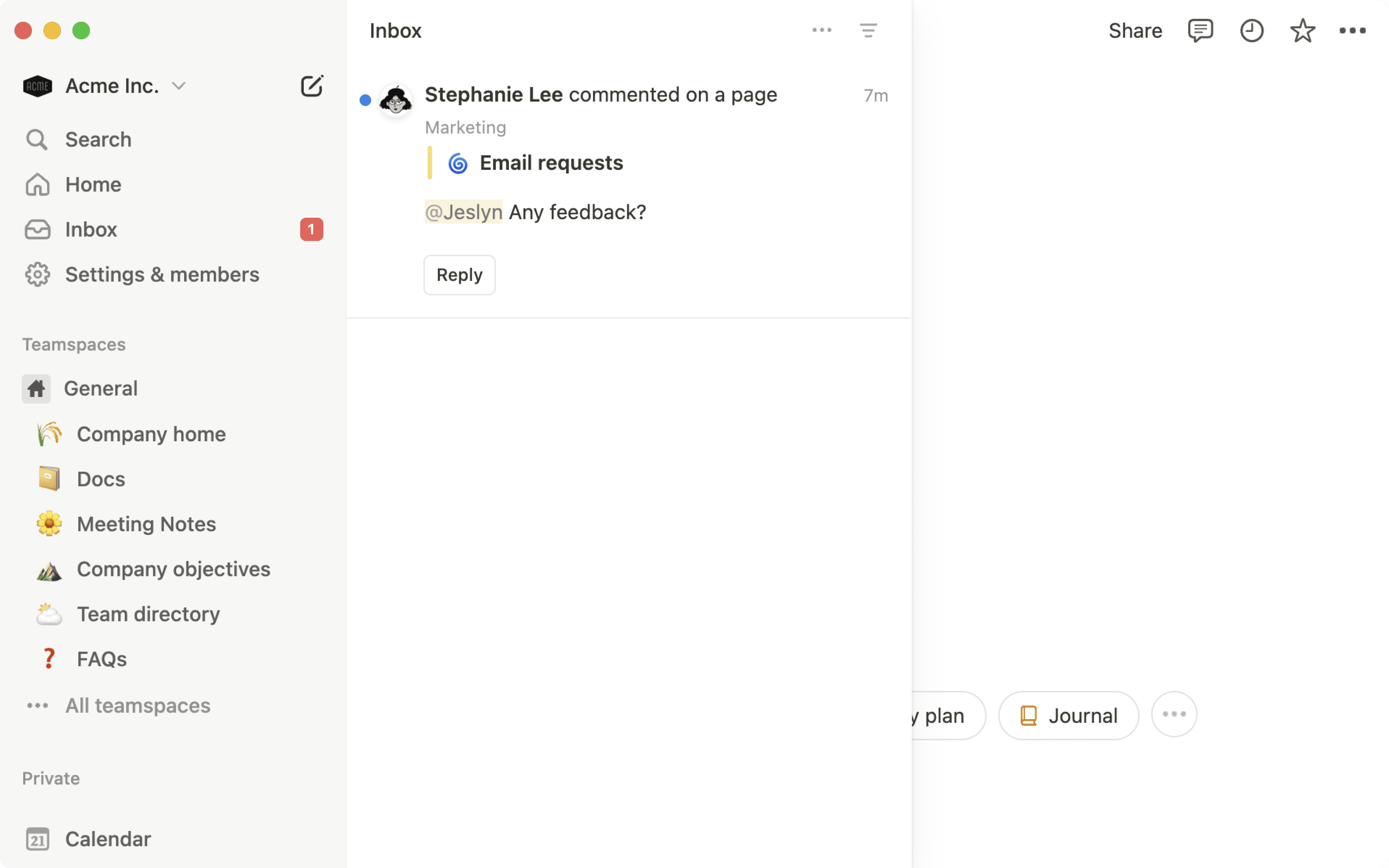
Zixflow
Zixflow has a native centralized inbox, where all the incoming messages from multiple channels are gathered for your convenience. You can easily handle your conversations by using this inbox to address customer concerns, interact with them in real time, and deliver fast customer service.
In addition to that, Zixflow’s inbox contains numerous filters, allowing you to see messages from a particular channel, during a specific time period, or based on its status. You can also get read receipts for your outbound sales campaigns and permission requests from internal team members that you can approve directly from the inbox as well.
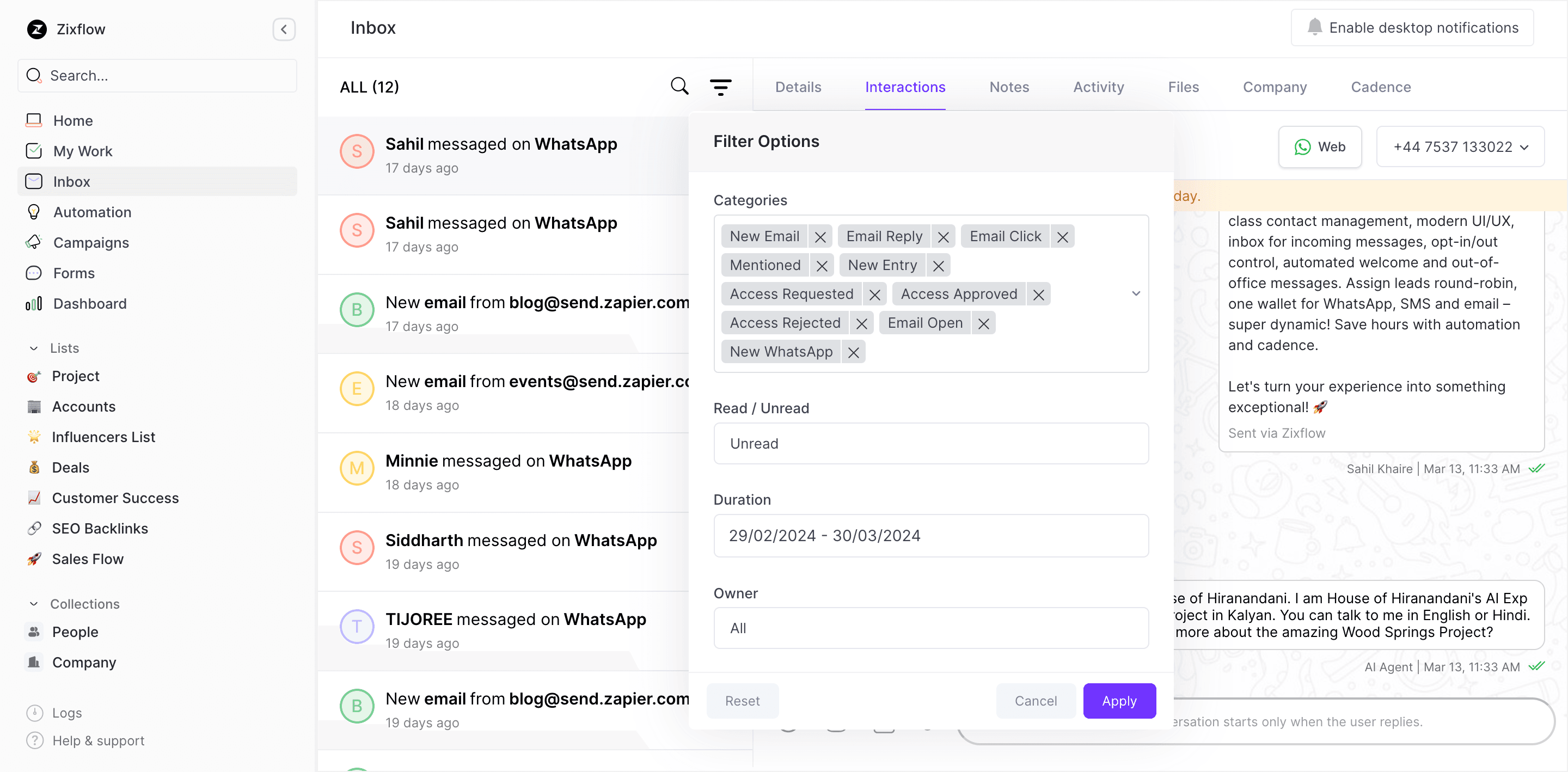
Manage your conversations effectively from one single location.
With Zixflow’s unified inbox, you don’t have to switch between multiple tabs and inboxes to find messages.
Get in TouchAPI integration
As you might have seen in this comparison, if you want to create your CRM software in a centralized hub, you will have to integrate it with other tools to facilitate you with the required capabilities to manage every aspect of your business. This is why, your CRM should support API integrations to help you optimize your processes and boost the overall sales efficiency of your teams.
Attio
Attio provides you with the ability to integrate the platform with many external solutions like Slack, Mailchimp, and Outreach, to name a few via REST API. Once the integration is complete, you can then automate your tasks and run email marketing campaigns effectively.
Notion
Similar to Attio, Notion also offers a flexible API to let you integrate it with third-party software for increased efficiency. By utilizing APIs, you can link Notion with pretty much any solution of your choice, be it a reporting dashboard or Google Sheets for the purpose of automating data entry.
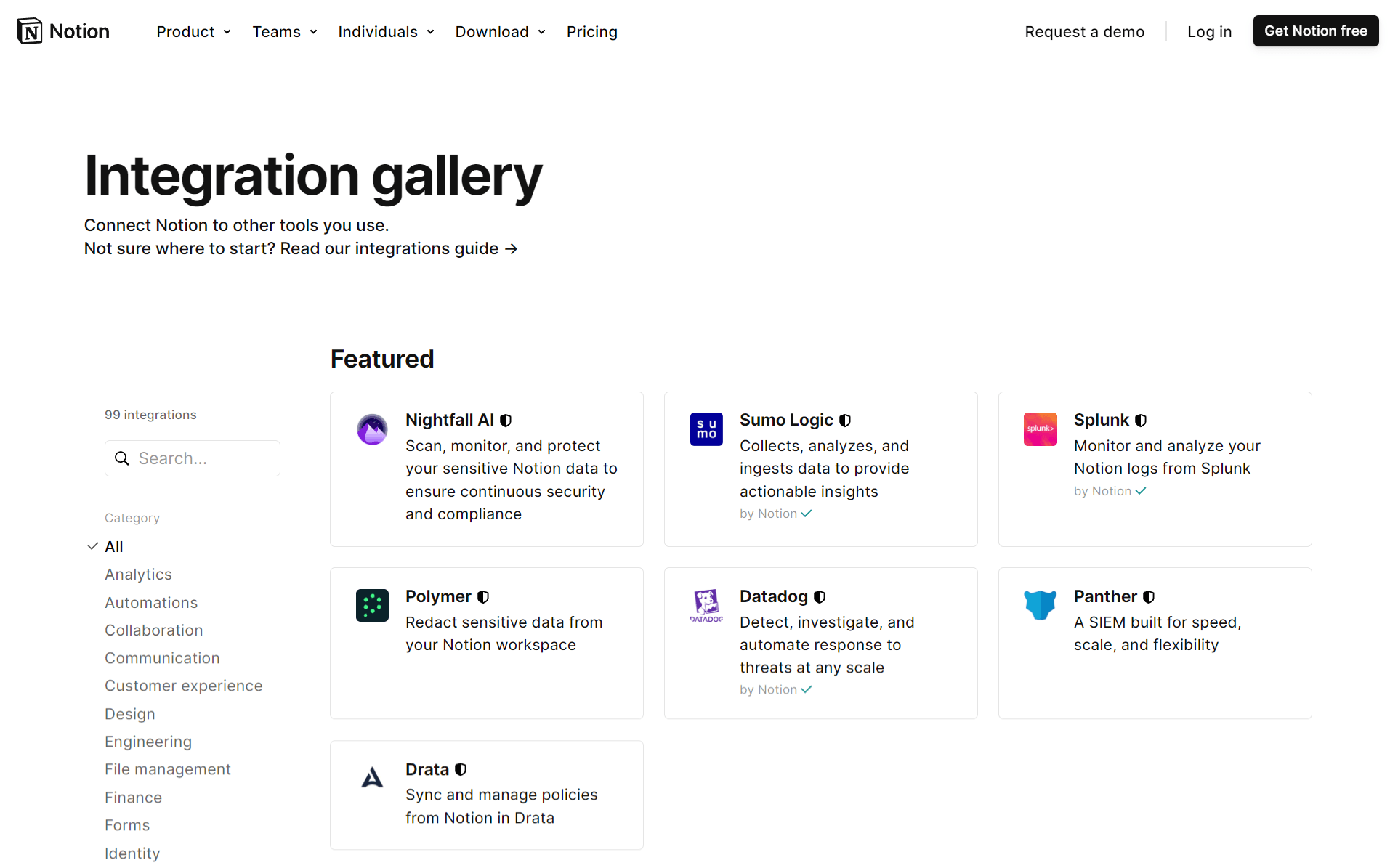
Zixflow
Zixflow supports powerful integration functionalities to convert the platform into a unified platform where you can easily keep track of your business. With one-click integrations to services like Outlook, Gmail, and Pabbly, you can sync your email address with the platform for easy handling of conversations.
Furthermore, to help you get started with APIs and webhooks, Zixflow provides in-depth API docs. By going through this documentation, you can set up custom integrations across thousands of platforms by utilizing app marketplaces like Zapier or Make for quick importing of customer data from multiple data sources.
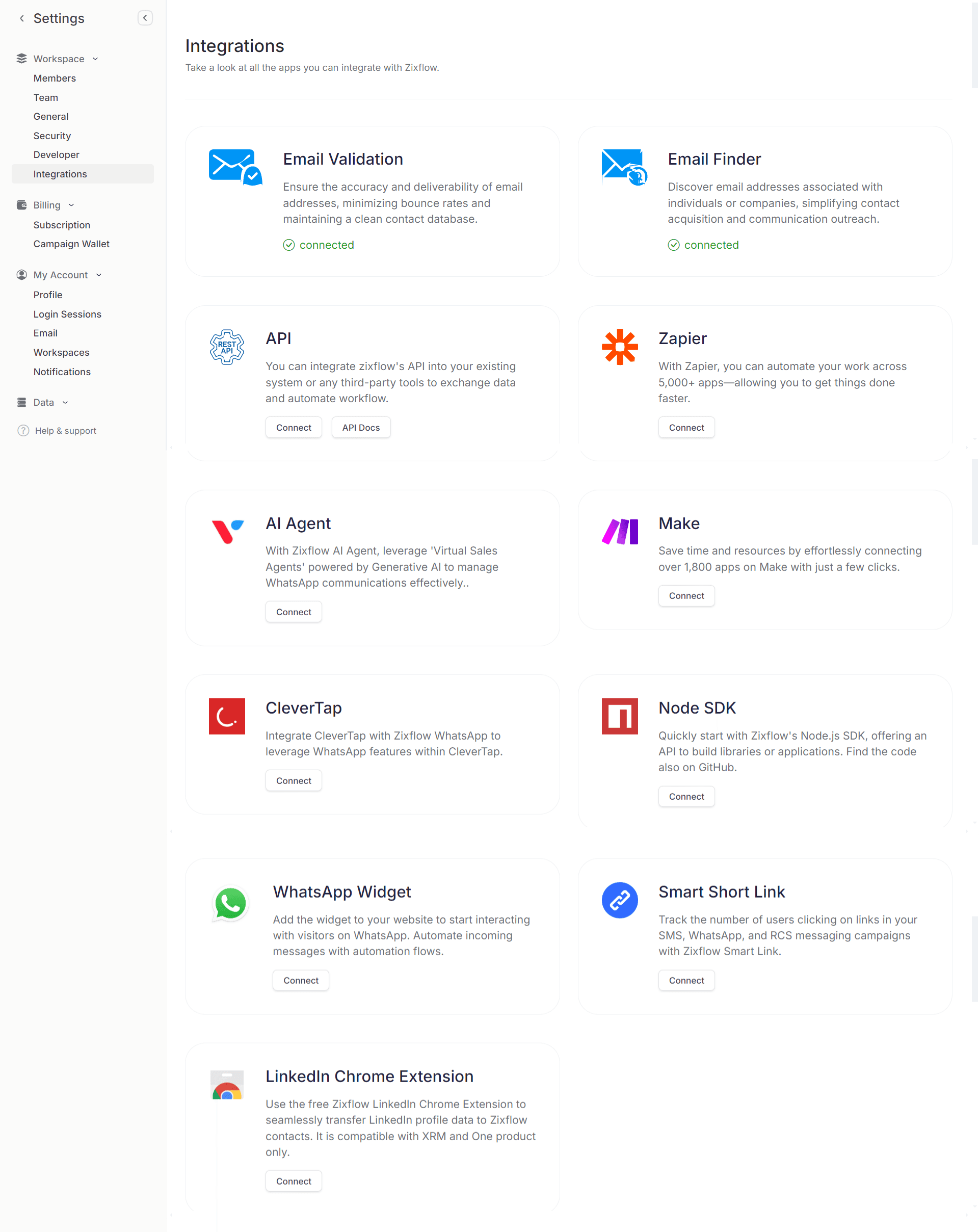
Attio, Notion, or Zixflow: Did you find the right tool for your business?
Overall, each of these platforms are great in their own way and allow you to manage contacts, reach out to them, and scale your business.
It’s up to you to choose the one that best matches your unique business needs and the objectives that you wish to achieve.
However, if I were to suggest one out of these three, then I would say, Zixflow. Although I am a little bit biased but Zixflow can truly help you drive engagement rates and help you hit those sales targets with effective inbound and outbound sales strategies.
Plus, with its advanced tagging and segmentation capabilities, you can manage your contacts in such a way that you don’t have to go through the entire database to find one in time of need.
So, take it out for a spin with the 7-day free trial and then decide whether you want to go for other solutions. There is a good possibility that you will stick to it.
